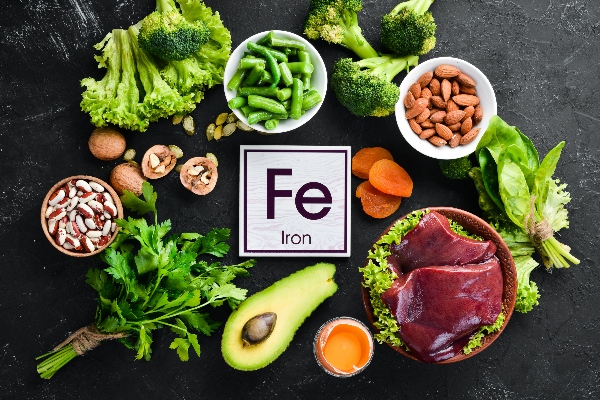What is iron deficiency anaemia?
Iron deficiency anaemia (IDA) is just one of many types of anaemia, and it means that you have too little iron in your blood. This can be as a result of blood loss, or due to pregnancy or heavy periods. Iron deficiency anaemia is common, and can be easily treated with tablets, or by eating foods that contain plenty of iron.

What causes iron deficiency anaemia?
- Pregnancy: If you’re pregnant, both you and your baby will need a lot more iron to make red blood cells. Iron deficiency anaemia can happen when your diet doesn’t contain enough iron.
- Heavy periods: Blood loss over a long period of time can deplete your body’s iron stores. Heavy periods can be treated with medicine.
- Diet: Some research has suggested that vegetarian women could be more susceptible to anaemia. However, further research would be needed to confirm a strong link.
Bleeding in the stomach and intestines is a common cause of iron deficiency anaemia, and this can be caused by the following:
- Taking non-steroidal anti-inflammatory drugs (NSAIDs), including ibuprofen and aspirin
- Bowel or oesophagus inflammation
- Stomach ulcers
- Piles
- Bowel or stomach cancers – this is less common
What are the symptoms of iron deficiency anaemia?
Common symptoms of anaemia
- Shortness of breath
- Tiredness or fatigue
- Palpitations or irregular heartbeat
- Pale or yellowish skin
- Feeling dizzy or lightheaded
- Chest pain
- Cold hands and feet
Less common symptoms of anaemia
- Headaches
- Hearing ringing, buzzing or hissing noises inside your head (tinnitus)
- Feeling itchy
- Food tasting strange
- A sore tongue
- Hair loss – more hair may come out more than usual when brushing or washing
- Difficulty swallowing
- Painful open sores (ulcers) in the corners of your mouth
- Spoon-shaped nails, which are usually a very late sign of iron deficiency anaemia
- Restless leg syndrome – an overwhelming urge to move the legs
It’s important to note that all the above symptoms can be caused by lots of other things. So, if you think you may have an iron deficiency, visit your GP for a full assessment.
If you’re an older person and are experiencing any of the above symptoms, it’s important that you book a doctor’s appointment as soon as possible.
How is iron deficiency anaemia diagnosed?
If you display any of the above symptoms and believe you might have iron deficiency anaemia, your GP will book you in for a blood test to check a number of factors. They’ll be looking to either confirm IDA or to look for other kinds of anaemia or to look for other causes of the symptom entirely.
They may run tests to look for the following:
- Red blood cell size and colour: if you have iron deficiency anaemia, your red blood cells might be smaller and paler in colour.
- Ferritin: This is a protein that helps store iron in your body. If you have a low level of ferritin, this usually indicates a low level of stored iron.
- Haemoglobin: If your haemoglobin levels are lower than normal, this could indicate anaemia. The normal haemoglobin range is generally 13.2 to 16.6 grams (g) of haemoglobin per deciliter (dL) of blood for men and 11.6 to 15 g/dL for women.
- Haematocrit: This is the percentage of your blood volume made up by red blood cells. Normal levels are generally between 38.3 and 48.6 percent for men and 35.5 and 44.9 percent for women. The value may vary depending on your age.
Prior to your blood test, your GP will ask you about your lifestyle and medical history. If they’re unable to determine the cause of your anaemia, it’s possible that they may refer you to a specialist to help with the diagnosis.

Treatment for iron deficiency anaemia
Iron tablets
Once your GP or a specialist has confirmed the cause of your iron deficiency anaemia, they’ll recommend the best treatment method for you.
One treatment method is by taking iron tablets, which will replace the iron that’s missing from your body. Do not take iron tablets without getting a blood test (unless you receive blood tests frequently, in which case you and your doctor may have come to an arrangement about self-medication). Although you may be experiencing iron deficiency anaemia symptoms, you may not be anaemic, and your symptoms might be caused by something else. In which case, it’s always best to firstly receive a diagnosis from a trained professional, rather than self-medicating.
Although iron tablets work well for most people, you may experience some of the following side effects:
- Constipation or diarrhoea
- Stomach pain
- Heartburn
- Feeling sick
- Black poo
To reduce the chance of side effects, try to take the tablets with food or soon after eating. Even if you do get side effects, it’s important to continue taking the tablets while you contact your GP at the same time. Allergic reactions to iron tablets are unusual.
To determine whether your iron level is improving, your GP might carry out repeat blood tests over the following months.

Eating foods that are rich in iron
If your diet is partly responsible for causing your iron deficiency anaemia, your GP may encourage you to eat some of the following foods that are rich in iron:
- Dark-green leafy vegetables like watercress and curly kale
- Meat
- Dried fruit such as apricots, prunes and raisins
- Pulses such as beans, peas and lentils
You may also be advised to eat and drink less of the following, which can make it harder for your body to store iron:
- Tea and coffee
- Milk and dairy
- Foods that contain high levels of phytic acid, such as wholegrain cereals. These can stop your body absorbing iron from other foods and pills
With the Evergreen Life app, you can measure and track areas of your wellbeing – including diet – and receive personalised tips on how to improve. Download the app and take the Nutrition Check to see how healthy your diet is.
- American Society of Hematology. (2021). Anemia. American Society of Hematology.
- Mayo Clinic. (2022). Anemia. Mayo Clinic.
- Mayo Clinic. (2021). Heavy periods: Can folic acid help? Mayo Clinic.
- Mayo Clinic. (2022). Iron deficiency anemia. Mayo Clinic.
- National Institute for Health and Clinical Excellence. (2021). What investigations should I arrange to confirm iron deficiency anaemia? National Institute for Health and Clinical Excellence.
- NHS UK. (2021). Iron deficiency anaemia. NHS UK.
- Pawlak R, Berger J, Hines I. Iron Status of Vegetarian Adults: A Review of Literature. Am J Lifestyle Med. 2016 Dec 16;12(6):486-498. doi: 10.1177/1559827616682933. PMID: 30783404; PMCID: PMC6367879.
- Tommys. (2018). Anaemia and pregnancy. Tommys.





